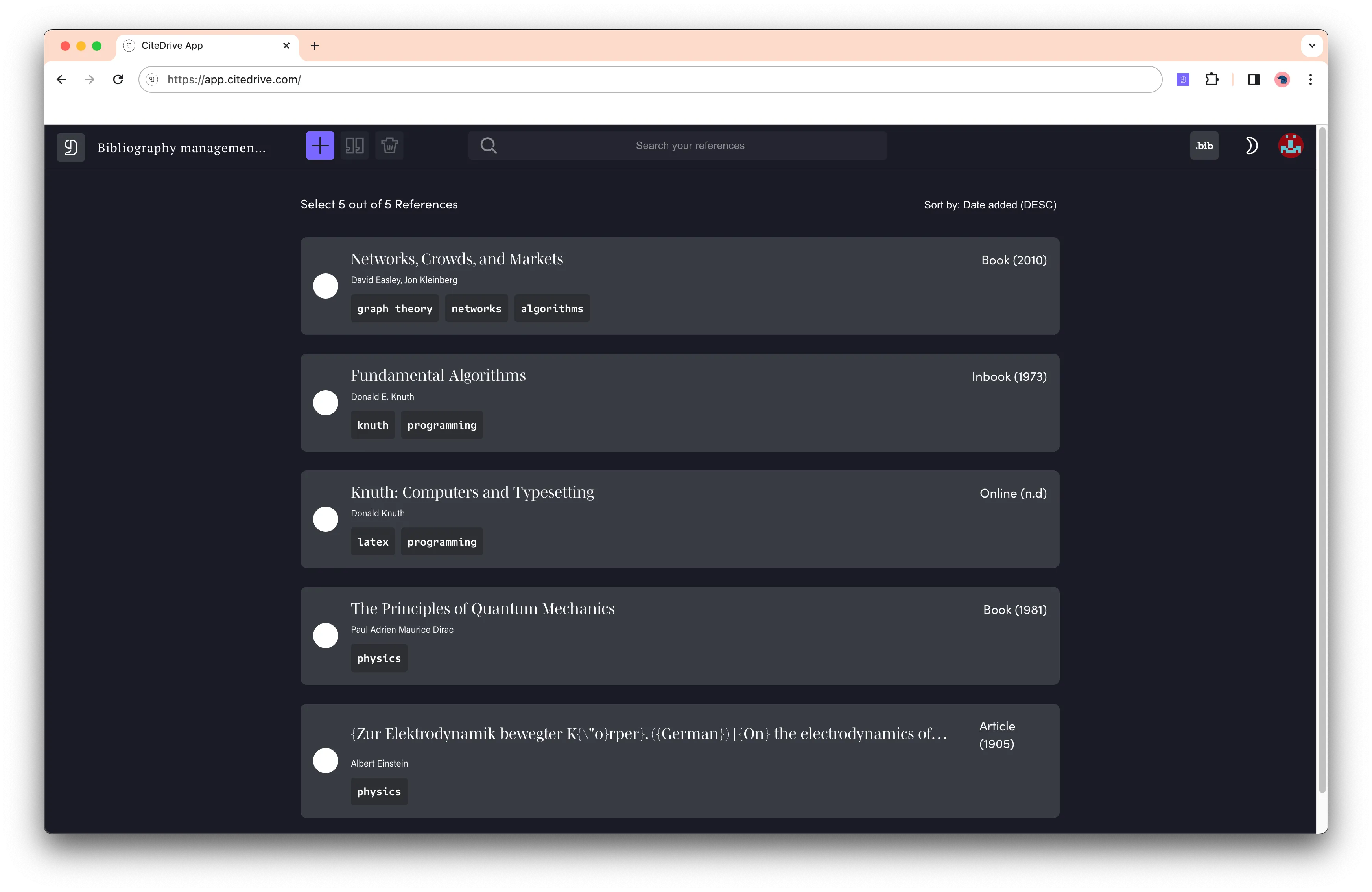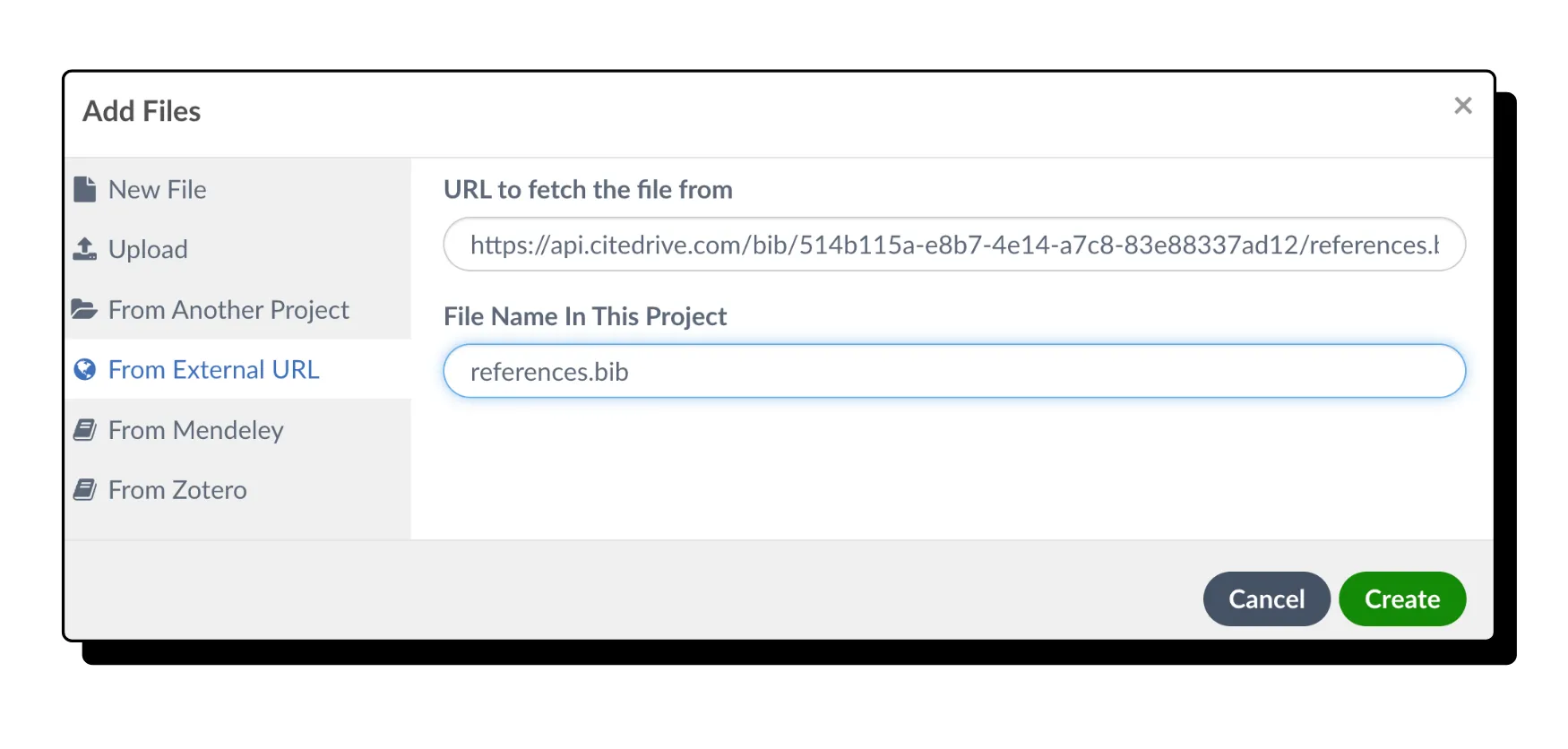在 Overleaf 上引用和使用参考文献:研究人员指南
在撰写研究论文时,使用参考文献来支持你的论点是非常重要的。正确引用你的来源是建立有力论证并避免抄袭的关键。本指南将向你展示如何使用 CiteDrive 在 Overleaf 上引用文献。我们还将提供一些在线查找可靠来源的提示。让我们开始吧!
步骤 1:将 CiteDrive 与 Overleaf 连接
如果你还没有登录 Overleaf,请先登录。然后,访问 CiteDrive,创建一个 Overleaf 项目,并 添加参考文献 到你的新项目。你的项目可能如下所示:

然后,点击项目左上角的“bib”。这将打开一个新的标签,显示动态的 BibTeX 文件,你可以将其用于 Overleaf,当你或你的团队成员添加、更新或删除项目中的参考文献时,它会自动更新。
最后,进入 Overleaf,创建一个新文件,选择“From External URL”,并将来自动态 BibTeX 的 URL 粘贴到“URL to fetch the file from”中,命名为 references.bib。 你的 CiteDrive 项目现在已经与 Overleaf 连接!记住,当你在 CiteDrive 项目中进行更改时,需要点击刷新,以确保 Overleaf 获取到最新状态。

步骤 2:在 Overleaf 中创建 TeX 文档
现在,让我们为 Overleaf 创建一个新的 tex 文件,我们可以将其命名为 “document.tex”。我们可以通过 \bibliography{references} 来定义来自 CiteDrive 的 BibTeX 文件。但是我们应该使用什么参考文献工具呢?在 LaTeX/Overleaf 中管理参考文献有许多选项:最常见的有 natbib、bibtex 和 biblatex。对于 LaTeX 中的参考文献管理,BibTeX 是主要的基础格式。使用 natbib,BibTeX 可以扩展,提供更多的文本内引用设计自由,而 biblatex 是对 BibTeX 的全面修订,提供更多的参考文献类型、排序和过滤选项,以及本地化功能。虽然 BibTeX 是最著名的程序,但 BibLaTeX 不仅同样强大,也是新手最推荐的程序。引用和参考文献数据保存在所谓的 .bib 文件中,正如你在 CiteDrive 的 BibTeX 文件中看到的那样,它的格式始终如下:
@article{smith201X, title = {An interesting article}, author = {John Smith}, year = {201X}, journal = {Journal of Interesting Articles} }这里 @article 是文献类型,title、author、year 和 journal 是用来在参考文献列表和引用中显示的属性,最后 smith201X 是一个唯一标识符,你可以在文档中引用它,通常使用 \cite{key}。CiteDrive 对格式要求不严格;任何字段和条目类型,只要适合你选择的参考文献包都可以使用。由于 CiteDrive 的基本目标是将文献数据与文档和引用样式分离,因此支持所有选项。
因此,我们提供了三种模板供你开始使用。
使用 BibTeX 开始:
如果你想从 BibTeX 开始,使用以下模板或直接在 Overleaf 中打开。更多关于 BibTeX 的信息,请查看文档。
\documentclass{article} \usepackage[utf8]{inputenc}
\title{BibTeX references in \LaTeX} \author{John Smith}
\begin{document}
\maketitle
Lorem ipsum dolor sit amet, consectetur adipiscing elit. Praesent enim urna, dapibus et bibendum vel, consectetur et turpis. Cras a molestie nulla. \cite{Hemingway1952} \medskip
\bibliographystyle{unsrt} \bibliography{references}
\end{document}使用 natbib 开始:
\documentclass{article} \usepackage{natbib} \bibliographystyle{apalike} \title{A Short Guide to Reference Management using natbib with BibTeX} \author{CiteDrive} \date {January 1988}
\begin{document}
\maketitle \textbf{叙述性引用:} \citet{Doe:1966} 研究了错误记录的风险 […],这导致了扭曲。 \textbf{括号内引用:} 错误记录的风险 […] 可能导致扭曲 \citep{Doe:1966}。
\medskip
\bibliography{references}
\end{document}更多关于 natbib 的信息,请点击这里。
使用 BibLaTeX 开始:
\documentclass{article} \usepackage{biblatex} \addbibresource{references.bib}
\begin{document} Lorem ipsum dolor sit amet, consectetur adipiscing elit. Praesent enim urna, dapibus et bibendum vel, consectetur et turpis. Cras a molestie nulla. \cite{Hemingway1952} \medskip
\printbibliography
\end{document}更多关于 BibLaTeX 的信息,请点击这里。
步骤 3:文中引用
如果你安装了浏览器扩展,你可以通过选择文本并点击工具栏中的 CiteDrive 图标来创建引用。
你也可以手动使用 cite 命令来引用。例如,如果你想引用 Smith (201X),你可以使用 \cite{smith201X}。或者使用 Overleaf 中的参考文献搜索。
Overleaf 上预安装了多种参考文献样式,取决于你使用的包,参考文献将显示在以下页面:
就这些!你现在应该已经拥有了在 Overleaf 中使用参考文献所需的一切。如果你有任何问题或反馈,请通过电子邮件告知我们,地址是 hello@citedrive.com。
祝 TeX 顺利!